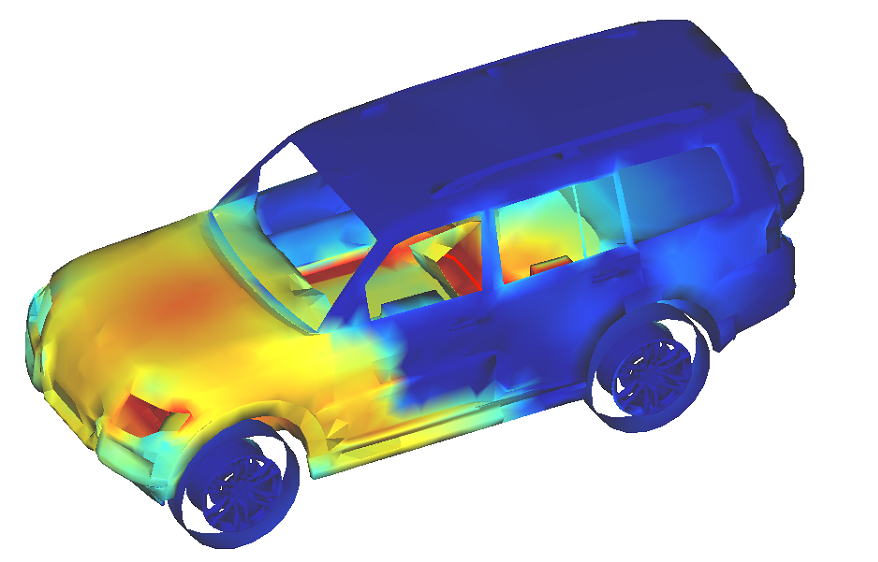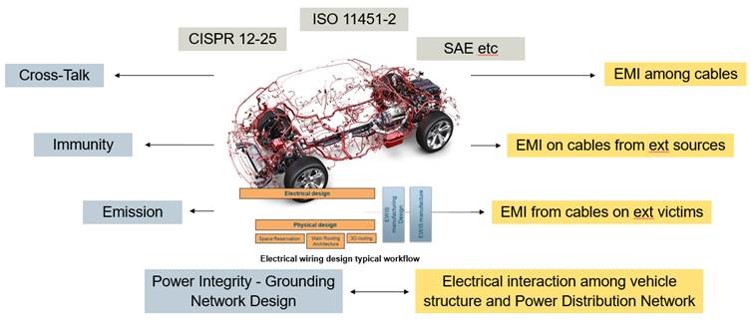Viewing the invisible: simulating electromagnetic performance

Today meets tomorrow: how electromagnetic simulation is helping developers with antenna technology and placement.
Autonomous vehicle driving involves communication between cars, infrastructure and other obstacles. Therefore, vehicle-to-everything (V2X) technology is needed to ensure its safety and reliability as it navigates throughout the roads, parking lots and neighborhoods.
Antenna capabilities give autonomous vehicles the ability to communicate with other vehicles that may not be visible to the human eye, for example, if it’s around a corner.
As the requests of connectivity to and from the vehicle increase, it is critical for designers and engineers to find the ideal locations for antennas while also considering all the constraints and complexities related to electromagnetic interference, mechanical, computational fluid dynamics and style issues. These growing complexities puts pressure on developers to maintain performance amid time-to-market and budget constraints. Bottom line: the trial-and-error approach is too expensive, too time-consuming and no longer acceptable.
From aircraft to the autonomous vehicle, antennas are a fundamental part of any communication and sensing system. Any platform/system aiming to transmit or receive information through an electromagnetic field is equipped with antennas and they represent a part of the processing chain of the signal/information between the source and the receiver.
Therefore, only a proper antenna design and the identification of the electromagnetic interaction between the antenna and the near surrounding environment can assure that both the required service levels and the control of the safety issues are met.
Designing the antenna
Antennas must operate in a complex environment and fulfill the requirements on the other parts of the system. They also have their own requirements such as shaped pattern, size, weight, installation constraints and regulations that need to be considered. And then, there’s the end use. For instance, the body design of a vehicle is a major part of a customer’s interest in buying it; antenna placement won’t likely factor into their design.

With complex electromagnetic environments, there is poised to be issues that need addressing long before producing and installing an antenna. There are three different classes of problems to consider:
Communication/sensing system. Antennas don’t work isolated in the deep space. They are installed on platforms, integrated in mobiles and personal computers, and many other locations. This means that designers must take into account the environmental effects on antenna performance at both antenna design and installation levels – for example, the interaction of an Advanced driver-assistance system (ADAS) radar antenna with the bumper may cause pattern distortion thus reducing ADAS radar performance.
- Interference among co-installed systems. The field radiated by an antenna may cause electromagnetic interference with other co-installed antenna-based systems. The power radiated by a transmitting antenna may couple to a receiving antenna thus causing a desensitization effect on the receiver. This runs the risk of potentially malfunctioning. Such electromagnetic interference risks must be controlled at design level.
- Safety, ordnance and fuel located close to transmitting antenna. High-power transmitting antennas create high E-H field levels in the surrounding areas which can be dangerous for people, ordnance and fuel. Detailed knowledge about near-field distribution is required in order to define the proper countermeasures.
Simulation as a problem solver
As the number of electronics in products continue increasing, engineers must understand how electromagnetic performance can potentially impact and interfere with product performance. For example, electrical motors, sensors and antennas are more prevalent. These components play a bigger role in the development process and must be part of electromagnetic simulation, which essentially means “viewing the invisible,” such as visualizing E-H field, currents, charge, voltages and energy/power distribution all along the 3D space.
Progress in the simulation technology means a comprehensive digital twin can provide valid support to address design issues in an effective and efficient way. Measurements are then used to tune the digital twin and to verify the performance of the final antenna and platform configuration.
The comprehensive digital twin could also help simulate the exact 3D reality, allow designers and engineers to explore the design space and find trade-off solutions both at the antenna level and installation level, including minimizing interaction with surrounding structures and interference with co-installed antennas and systems.
Just like simulation technology applied in other disciplines, electromagnetic simulation can be used for multiple purposes like analysis, diagnostic, support to measurements definition, measurements understanding and support to certification.
Finally, simulation allows for faster prototyping and more efficient exploration of the space of solution in the early design phase, when no hardware is available, and can assess the effect of the aging of materials, conductors, the effect of the modification of the electromagnetic environment as well as the impact of the physical environment. It also can minimize acceptance, qualification and certification failure risk.
Without simulation, autonomous vehicles would have to be tested on 11 billion of miles of road — an unrealistic and impossible task. Simulation is helping reduce the process from months down to days. That’s why developers are increasingly using digital twin and simulation to test and validate antenna systems. Problems are less expensive and time consuming to solve because issues are identified sooner in the development process.
Comprehensive and collaborative software and solutions are part of the Siemens Xcelerator portfolio and can help developers use simulation and digital tools efficiently and effectively.
Learn more about Xcelerator at https://www.sw.siemens.com/portfolio/
Sign up for our upcoming webinar, Mitigate electromagnetic compatibility and interference in the context of vehicle electrification, to learn more about electromagnetic compatibility and interference issues and what tools are helping resolve these challenges.


